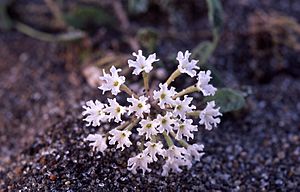Yellowstone sand verbena facts for kids
Quick facts for kids Yellowstone sand verbena |
|
|---|---|
 |
|
| Conservation status | |
| Scientific classification |
The Yellowstone sand verbena (scientific name: Abronia ammophila) is a special plant found only along the lakeshores of Yellowstone National Park. This means it is endemic to the park, growing nowhere else in the world! It belongs to the "Four o'clock" plant family, also known as Nyctaginaceae. This plant loves sandy soils and lake edges.
It's quite surprising to find a sand verbena plant in Yellowstone. The park is very high up, about 7,740 feet (2,360 meters) above sea level, and has long, cold winters. Most plants in the Abronia group, which includes about 30 different species, usually live in much warmer places like deserts in the western United States and Mexico.
Some plant experts think that Yellowstone's hot springs and other thermal activity might help the sand verbena survive the cold winters. Over a long time, this plant might have slowly changed to fit in with Yellowstone's unique climate.
Scientists have found four groups of Yellowstone sand verbena plants recently. However, they still have a lot to learn about how the plant lives and grows. For example, it was once thought to be an annual plant, meaning it lives for only one year. But now we know it's a perennial, which means it lives for many years. It survives the winter underground with a large root system.
Where Does the Yellowstone Sand Verbena Grow?
This special plant used to be found in more places around the lake in Yellowstone. Sadly, its population has shrunk quite a bit. Between 1998 and 2010, the number of these plants in the park went down by 56%. This happened mostly because people walked on them and their natural home was damaged.
What Does the Yellowstone Sand Verbena Look Like?
The Yellowstone sand verbena is a perennial herb. This means it's a plant that comes back year after year. It has stems that lie flat on the ground, growing up to about 16 inches (4 decimeters) long. These stems feel sticky and have tiny hairs on them.
In July and August, the plant blooms with clusters of whitish, tube-shaped flowers. These flower clusters are surrounded by five oval-shaped leaves called bracts.
Images for kids



